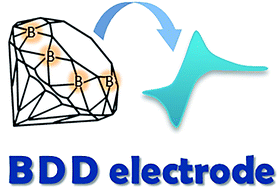Boron-doped diamond: current progress and challenges in view of electroanalytical applications
Abstract
This review examines the current status (from 2016 to December 2018) of the electroanalytical application of boron-doped diamond (BDD), in view of its advantages and challenges for electroanalytical applications. The effect of the boron-doping level, sp3/sp2 ratio, and BDD surface termination on the electrochemical properties of BDD electrodes is discussed. The most interesting and significant developments concerning the electrochemical oxidation and reduction of chemical substances onto BDD in single and multi-analyte modes, the beneficial role of surfactants in BDD electrode-based electroanalysis, surface modifications, modification of electrode surfaces with metal nanoparticles, porous BDD surfaces, and the specificity of BDDEs in the microfluidic context, are considered. Basic information on the electroanalysis of organic substances in single- and multi-analyte detection modes is given in the tables. Other non-common electroanalytical applications of BDD, such as BDD as an electrode material for electrogenerated electrochemiluminescence, and BDD for in vivo on-line determination of analytes, detecting bio-potential changes in plants, and pH and gas sensing, are presented.

- This article is part of the themed collections: Recent Review Articles and In celebration of Chinese New Year 2020


 Please wait while we load your content...
Please wait while we load your content...